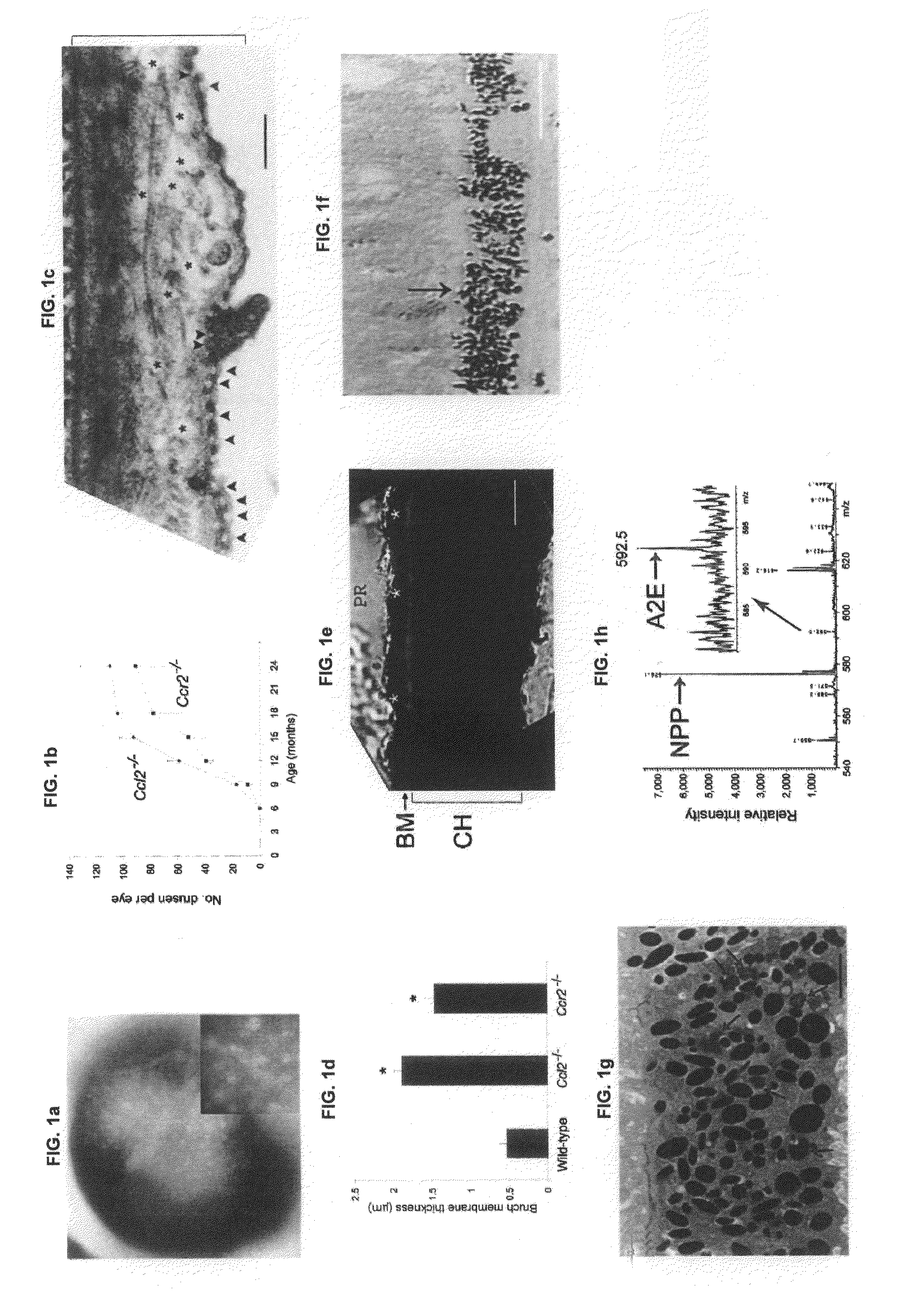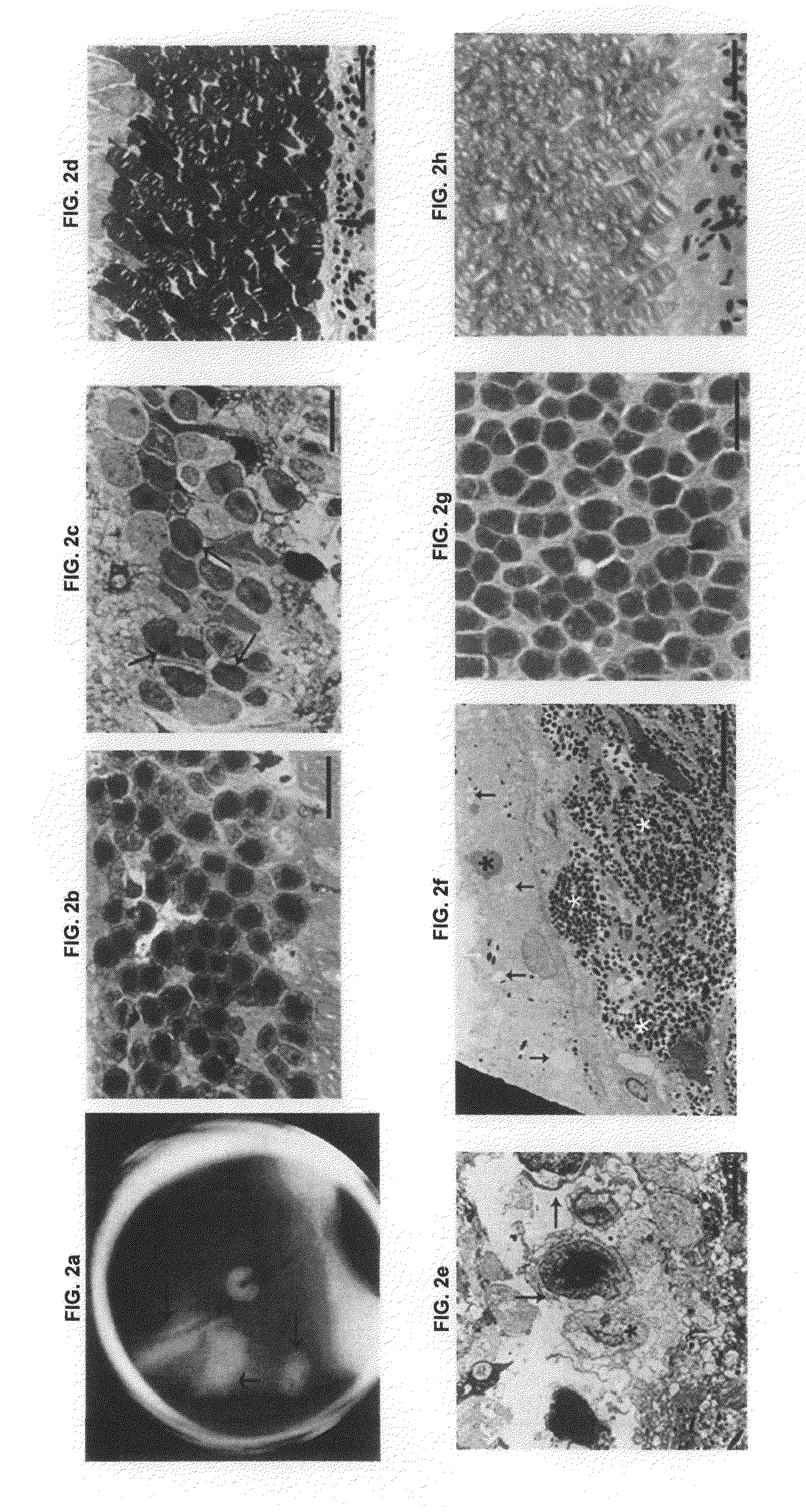Methods and animal model for analyzing age-related macular degeneration
a technology animal models, applied in the field of age-related macular degeneration pathology determination, can solve the problems of hampered study and treatment of age-related macular degeneration, without a faithful animal model of amd
- Summary
- Abstract
- Description
- Claims
- Application Information
AI Technical Summary
Benefits of technology
Problems solved by technology
Method used
Image
Examples
example 1
[0065]Eyes of greater than 60 Ccl2 / and Ccr2− / − mice and 40 age-matched wild-type mice ranging from 3 to 27 months were subjected to fundus examination. Of these, eyes from 25 Ccrl− / −, 21 Ccr2− / − and 18 age-matched wild-type (24 months: 5) mice were extensively examined histopathologically. Before 9 months of age, the fundi of Ccl2 / and Ccr2− / mice were indistinguishable from wild-type mice. Thereafter subretinal deposits with ophthalmoscopic and pathologic features of drusen in patients with AMD were observed in all mice of both knockout strains and increased in number with age as in humans (FIG. 1a, b). In contrast, no such changes were visible in wild-type mice even at 24 months of age (n=5). Bruch's membrane (the extracellular matrix between the RPE and choroid) was markedly thickened in senescent Ccl2 or Ccr2 deficient mice compared with age-matched wild-types and that its collagen and elastin layers were severely disrupted with internal fragmentation (FIG. 1e), features observed...
example 2
Retinal Degeneration and Choroidal Neovascularization in Ccl2− / − and Ccr2− / −mice
[0066]As Ccl2− / − and Ccr2− / − mice aged, they exhibited several of the late findings seen in human AMD, including progressive outer retinal degeneration and CNV, similar to that seen in patients with late AMD. Despite evidence of RPE and choroidal pathology, differences in neural retinal morphology between knockout strains and wild types were not observed before 16 months of age. At 16 months of age and thereafter, both knockout strains exhibited confluent areas of visible atrophy similar to “geographic atrophy” seen in advanced AMD (FIG. 2a). These areas were characterized by cell loss in the outer nuclear layer of the retina and atrophy of photoreceptor segments (FIG. 2b-e), as well as attenuation of the RPE and choriocapillaris (FIG. 20 as in late AMD. In these regions the RPE was hypopigmented along with prominent vacuolization and degeneration of most intracellular organelles, and was devoid of basal...
example 3
[0067]CCR2 rescue of the ocular abnormalities in Ccr2 deficient mice is accomplished by creating chimeric mice using bone marrow transplantation (BMT). In vitro AAV transduction results in loss of stem cell activity during infection, while in vivo transduction results in non-specific and low-level target expression (only 1 per 15,000 bone marrow cells are stem cells); neither approach will guarantee sustained expression in vivo. Ccr2 − / − mice are irradiated and repopulated with bone marrow stem cells from wildtype Ccr2 + / + mice. Ccr2 − / mice are maintained on antibiotic-containing water for one week before irradiation. These mice are irradiated with 900 cGy from a cesium source (delivered in two equal doses of 450 cGy 3-4 hours apart), and donor bone marrow cells (1×107) are injected into a tail vein. Mice are maintained on antibiotic containing water for four weeks after transplantation. Engraftment is verified by PCR detection of the Ccr2 gene in the bone marrow of all irradiated m...
PUM
| Property | Measurement | Unit |
|---|---|---|
| thickness | aaaaa | aaaaa |
| volume | aaaaa | aaaaa |
| mass spectometry | aaaaa | aaaaa |
Abstract
Description
Claims
Application Information
 Login to View More
Login to View More - R&D
- Intellectual Property
- Life Sciences
- Materials
- Tech Scout
- Unparalleled Data Quality
- Higher Quality Content
- 60% Fewer Hallucinations
Browse by: Latest US Patents, China's latest patents, Technical Efficacy Thesaurus, Application Domain, Technology Topic, Popular Technical Reports.
© 2025 PatSnap. All rights reserved.Legal|Privacy policy|Modern Slavery Act Transparency Statement|Sitemap|About US| Contact US: help@patsnap.com



